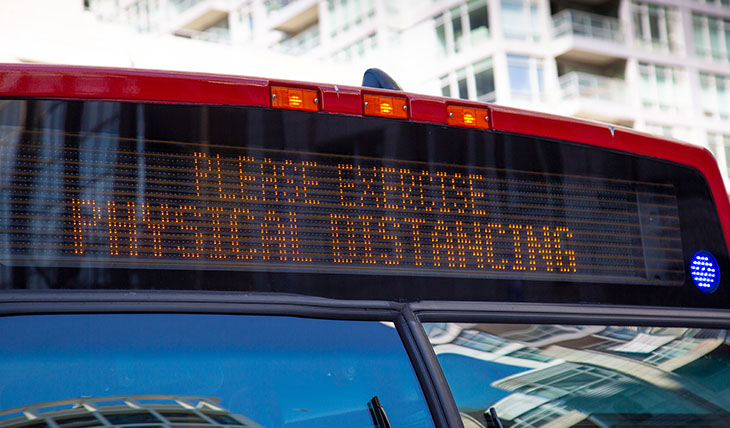6 Important Transit Trends for 2021-2022, Post-COVID-19

Transit agencies have faced numerous challenges during the global pandemic. Some relate to acquiring funding for things like enhanced transit software, others pertain to achieving more equitable fare payment, and most face challenges concerning community health and safety. Through a series of interviews with transit leaders around the US, the Community Transportation Association of America (CTAA), has identified six emergent transit trends to address these challenges, and preserve the future of public transit.
6 Transit Trends
1. Make public health a new transit focus
Transit agencies are starting to envision transit beyond the once typical “9 to 5” commute. Services like providing rides to vaccines and other preventive public health programs, are helping them build new post-pandemic ridership. From seasonal flu vaccine access to possible COVID-19 vaccine boosters, transit agencies have begun to build on pandemic partnerships to strengthen the connection between transportation and healthcare outcomes in their communities.
Santa Rosa CityBus’ Rachel Ede says that prior to the pandemic, she “had a personal to-do list as transit manager to build a relationship with her public 45 health counterparts” to promote transit access to medical services, mental health services, healthy food, and outdoor recreation. Because of close collaboration during the pandemic, “we are on their radar now…there’s lots to explore together, like promoting transit services through public health channels, and exploring the potential for special fares to health resources.”
2. Make fare payment more equitable
As a reward to their customers for getting vaccinated, and to promote transit use, some agencies are making fare payment fairer and more equitable. For example, Greater Dayton RTA (GDRTA) is giving a month of free rides to any customer who is fully vaccinated. When customers show proof of full vaccination to a transit ambassador at any of their five transit hubs, GDRTA provides a $30 fare credit on TAPP Pay, its new fare 46 payment system, launched in the Spring of 2021.
Some agencies are also implementing fare-free service, to enhance equity and inclusion for riders. Because of provisions in the COVID-19 emergency relief legislation that permit federal funding for 100% of eligible operating expenses, agencies can move forward with fare-free transit, while simultaneously making progress on critical capital projects that receive separate federal matching funds.
3. Focus Federal/State support on frequent & reliable service
A new set of challenges require rethinking how federal and state funds are invested in transit. The $69.5 billion in federal funding under the CARES Act, CRRSAA, and American Rescue Plan, represents a milestone for federal transit funding in two ways: 1) it requires no local match for COVID-19 related expenses, and 2) it is the first time since 1981 that the federal government has provided significant operational funding for public transit. This is vital, considering now, more than ever, federal funding is critical to keep service running.
4. Strengthen hiring and career development
Attracting and retaining skilled employees is an ongoing challenge for transit agencies, and the pandemic has exacerbated this challenge. “One of our biggest challenges is hiring. We can’t get enough drivers, and it’s a direct result of the pandemic,” says Brandon Policicchio of GDRTA. The focus on essential workers during the pandemic has increased awareness of the core value of transit to communities. At the same time, safety and health concerns prompted by the pandemic have driven some people away from working in frontline jobs driving vehicles and interacting with customers. The industry needs to think creatively about building its workforce.
Ryan Brumfield of NCDOT says a national salary study could help transit agencies hire more competitively in an increasingly tight labor market. Understanding the motivations of people who choose adjacent transportation work, like package delivery or ride-hailing, instead of jobs in public transit will help transit agencies strengthen their incentives and benefits to attract those people to transit. Leveraging new and renewed relationships with community and social service organizations help to ensure that hiring opportunities reach people from disadvantaged and underserved communities.
5. Redesign routes and add more frequent services
“Once you’ve experienced living at the scale of a neighborhood, why would you go back to congested streets and a long commute?” That’s the challenge facing transit, according to Jennifer Keesmaat, former Chief Planner for the City of Toronto. “It would be a waste to put it all back the way it was before,” Policicchio says, urging transit agencies to use this time to redesign service to be more resilient and useful. He also advises agencies to be cautious about how they communicate with customers about their financial state. “Don’t overpromise and make the cliff bigger. If transit agencies don’t adapt, that cliff is going to come when federal funding runs out.” Greg Jordan of Greater Portland METRO echoes Policicchio’s concern.
6. Expand demand response/microtransit services
Early in the distribution of vaccines, transit providers used their demand response and paratransit fleets to provide free rides for vaccination. This made sense because vaccine eligibility started with seniors and people at high-risk for health complications if they contracted COVID-19, a natural overlap with paratransit.
Some providers, like SPARTAN Public Transit, waived age and physical ability requirements usually associated with their door-to-door demand-response services and provided rides to anyone who needed one to get vaccinated.
Microtransit could potentially help ridership grow to fixed-route levels, or simply serve areas well that don’t warrant fixed-route frequency. Microtransit apps like TripSpark's Rides on Demand are gaining popularity with transit agencies as they continue to expand their ridership services. Experimentation and collaboration are also propelling agencies forward. Wave Transit’s Megan Matheny says the agency is preparing to introduce microtransit in partnership with New Hanover County and Brunswick County. By pooling resources, the transit agency and the county can start the service.
A better future for transit
As transit providers and community leaders take stock of the pandemic’s impact, several opportunities have emerged to address the challenges that our communities are facing, and build a better future – with transit front and center. The CTAA's analysis of our industry's response to the changes and challenges that have surfaced due to COVID-19, reveal just how resilient and innovative we are, as we continue to rise to the occasion.
Source: https://ctaa.org/wp-content/uploads/2021/07/CTAA_Vaccine_Transit.pdf

